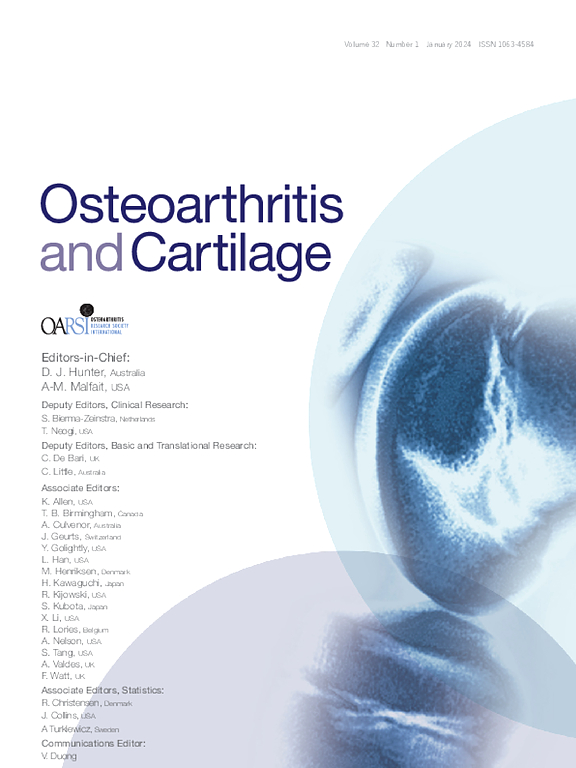The impact of an illness perception conversation on open-label placebo response in knee osteoarthritis: A randomised controlled trial
IF 7.2
2区 医学
Q1 ORTHOPEDICS
引用次数: 0
Abstract
Objective
To compare the effect of an illness perception conversation (IPC), relative to a research participation conversation (RPC), on 2-week changes in knee pain in patients with knee osteoarthritis.
Method
This was a randomised single-blind trial. Patients were randomised to two matched conversations. An IP conversation concerning the participant’s knee pain-related illness perception (IP) or an RPC concerning the participant’s motivation for participating in research. Both conversations were followed by an open-label intraarticular saline injection in the most symptomatic knee. The primary outcome was change in knee pain from baseline to 2 weeks follow-up on a 100 mm visual analogue scale (VAS). Key secondary outcomes included the Knee injury and Osteoarthritis Outcome Score (KOOS) subscales: Activities of daily living (ADL) and Quality of life (QoL). Main analyses were based on the intention-to-treat population using repeated measures mixed effects linear models.
Results
103 patients were randomised to the IPC group (n = 52) and the RPC group (n = 51). VAS knee pain scores changed statistically significantly from baseline to end of treatment in both groups, −13.7 (standard error [SE]: 3.2) in the IPC group and −13.0 (SE: 3.1) in the RPC group with an adjusted between-group difference of −0.7 (95% CI: −8.3 to 6.9; P = 0.85). Likewise, no group differences were seen in KOOS ADL and KOOS QoL.
Conclusion
A conversation concerning knee pain-related IP did not augment the pain-relieving effect of an open-label placebo injection when compared to a similar control conversation concerning motivations for participating in research.
Trial registration
NCT05225480.
疾病认知谈话对膝关节骨性关节炎开放标签安慰剂反应的影响:随机对照试验
目的比较疾病认知对话(IPC)与研究参与对话(RPC)对膝关节骨性关节炎患者膝关节疼痛两周变化的影响:这是一项随机单盲试验。患者被随机分配到两个匹配的对话中。疾病认知(IP)对话,涉及参与者与膝关节疼痛相关的疾病认知;研究参与对话,涉及参与者参与研究的动机。两次对话后,在症状最严重的膝关节内注射开放标签的关节内生理盐水。主要结果是膝关节疼痛从基线到随访 2 周的变化,采用 100 毫米视觉模拟量表(VAS)。主要次要结果包括膝关节损伤和骨关节炎结果评分(KOOS)分量表:日常生活活动 (ADL) 和生活质量 (QoL)。主要分析基于意向治疗人群,采用重复测量混合效应线性模型:103名患者被随机分配到IPC组(n = 52)和RPC组(n = 51)。从基线到治疗结束,两组患者的 VAS 膝关节疼痛评分均有显著的统计学变化,IPC 组为-13.7(SE:3.2),RPC 组为-13.0(SE:3.1),调整后的组间差异为-0.7(95% CI:-8.3 至 6.9;P= 0.85)。同样,在 KOOS ADL 和 KOOS QoL 方面也未发现组间差异:结论:与关于参与研究动机的类似对照对话相比,与膝关节疼痛相关的IP对话并不能增强开放标签安慰剂注射的止痛效果:试验注册:NCT05225480。
本文章由计算机程序翻译,如有差异,请以英文原文为准。
求助全文
约1分钟内获得全文
求助全文
来源期刊

Osteoarthritis and Cartilage
医学-风湿病学
CiteScore
11.70
自引率
7.10%
发文量
802
审稿时长
52 days
期刊介绍:
Osteoarthritis and Cartilage is the official journal of the Osteoarthritis Research Society International.
It is an international, multidisciplinary journal that disseminates information for the many kinds of specialists and practitioners concerned with osteoarthritis.
 求助内容:
求助内容: 应助结果提醒方式:
应助结果提醒方式:


